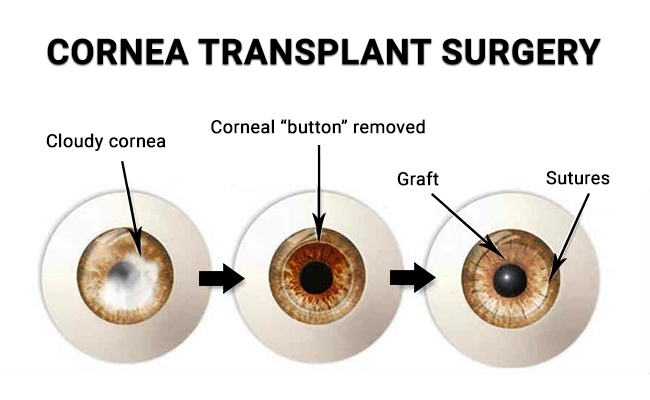 (212) 861-9797
(212) 861-9797
 (212) 861-9797
(212) 861-9797
A damaged or diseased cornea can interfere with your vision. Since your eyes are so vulnerable, you need to have your eyes checked regularly. The ophthalmologists at Vitreous Retina Macula Consultants of New York in Manhattan, Brooklyn and Westchester have the knowledge, training and equipment to diagnose your cornea problem and treat it. The best cornea transplant doctors can transplant part or all of your cornea. Cornea transplant surgery is safe and effective, and it preserves your vision. Call VRMNY eye surgery centers for a consultation.
The cornea is the outermost layer of your eye. Its primary function is to protect your eye. In fact, the cornea shields the inner eye from germs, dust and damaging ultraviolet (UV) wavelengths in sunlight. But protection isn’t its only purpose.
Your cornea also bends or refracts light onto the retina at the back of your eyeball. This refractive ability contributes the largest percentage — about 70 percent — of your eye’s focusing power. By focusing light into your eye, the cornea contributes to its overall refractive power.
When you suffer from corneal disease or any injury, an early diagnosis helps you get effective treatment. At Vitreous Retina Macula Consultants of New York (VRMNY) eye surgery centers, the Surgical procedures, such as keratoplasty or a cornea transplant
Because it has no blood vessels of its own, the cornea relies on tears and the aqueous humor in your eye’s anterior chamber for nutrients. The cornea has five layers: the epithelium, Bowman’s layer, the stroma, Descemet’s membrane and the endothelium. Any disease or injury to these layers can lead to vision problems.

Cornea transplant is a surgical procedure to remove a part or all of a damaged cornea. Then, your eye doctor replaces it with healthy corneal tissue or a graft from a donor. Your eye doctor removes a cornea if it’s diseased or you’ve suffered serious eye damage. The main types of corneal transplants include:
Your ophthalmologist chooses the best cornea transplant procedure for you after a careful diagnosis. These procedures have delivered impressive results that have improved vision and reduced the severe symptoms associated with corneal disease. VRMNY — with locations in Manhattan, Westchester and Brooklyn — has the best cornea transplant doctors and the latest medical equipment.
Dr. Slakter and the team are the very best. They have been taking care of me for the last 15 years or so and it is really more than the outstanding medical specialty, which goes without saying. It is also the human care and personal consideration that makes me feel part of a team that really cares about me and all other patients equally!
MOSES D. GoogleEye doctors rely on corneal transplants for a variety of conditions and diseases. The conditions that make you a good candidate for a cornea transplant surgery include:
If you have any of these symptoms and you have good overall health, consult the best eye doctors in NYC at VRMNY. After diagnostic imaging tests and a review of your medical history, your eye doctor determines if you’re a suitable candidate for eye cornea transplant.
Your cornea transplant doctor follows the diagnosis to determine the most appropriate cornea transplant for the best results. Each surgical procedure may be slightly different to account for your condition, but most follow similar steps, including:
The post-operative care instructions differ, depending on your procedure. Your eye doctor always advises against rubbing your eye and avoiding strenuous activities or lifting during the first few weeks. Try to avoid irritants like smoke and keep shower water from getting into your eye for several weeks. An eye patch protects your eye. Your ophthalmologist provides steroid or antibiotic eye drops for daily use.
If you’re suffering vision problems, get a diagnosis from the best cornea transplant doctors in NYC. The ophthalmologists at Vitreous Retina Macula Consultants of New York have the skills and technology to perform vision-saving eye surgeries. Their reputable eye specialists have published extensively and developed leading-edge eye procedures. Contact VRMNY today to schedule your appointment.
Let us help you enjoy your life
Call: (212) 861-9797To Speak With An Appointment Coordinator Now